7 Weeds With Purple Flowers in Your Lawn
Author: Chris Miller | Editor: Omar Alonso
Review & Research: Jen Worst & Chris Miller
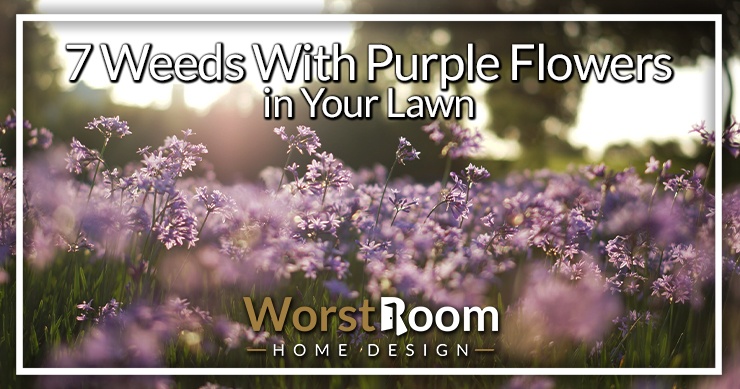
Weeds are the archnemesis to many homeowners or those who handle properties. However, it can be hard to want to mow down or kill off some weeds that offer a vibrant glow to a home or garden. You may think these lawn weeds with purple flowers are pretty... for now.
Although weeds are famously invasive and can cause some damage to other plants in your garden, these purple flowering weeds can look stunning and make your lawn look pretty.
The first step to dealing with these small purple flowers in your grass is to identify the type of weed taking over your lawn. You can do this by knowing what the most popular purple weed flowers look like. Read on to learn more about purple flower weeds, how to identify them, and more.
What Do Flowering Weeds Look Like?
Flowering weeds with purple in their makeup can look like normal flowers to the untrained eye. Most will have flowers with purple or pinkish tones on the top or nearby green leaves. Most purple weeds don’t have only purple on them but also green leaves and other features that make them look flower-like.
Some purple weeds can come in bunches, while others will have more purple than others. Identifying these weeds can be difficult, so knowing the most common purple weeds can help you figure out how to best handle your lawn and garden care.
7 Weeds With Purple Flowers
These weeds have purple flowers that can be hypnotic and make you want to avoid cutting them down - even though cutting them can positively impact your lawn and garden. Consider how similar these weeds look to the type in your yard or garden.
Wild Violet
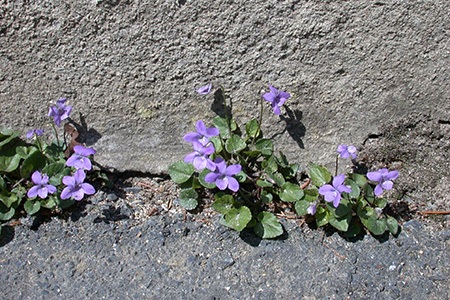
Wild violets (Viola papilionacea) are also called blue violets (Viola sororia) due to their color. These violet varieties are winter weeds and will crop up during cold weather and the cold season. These plants have heart-shaped leaves and usually five petals. Interestingly, wild violets aren’t always purple. Sometimes, these flowers are yellow or white. In some cases, wild violets will grow with multiple colors in their bunches.
Wild violets prefer shaded locations, so they’ll be happy to grow against your house wall or another shaded area in your lawn where they can hide from the sun. When the conditions are right for them, wild violets can survive for two years, creeping along your garden and lawn. You could also be dealing with purple weigela plants.
Forget-Me-Not
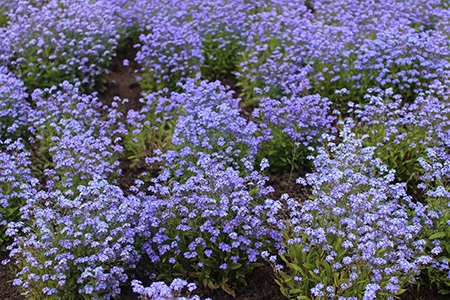
Forget-me-nots were once called Scorpion-grass, and are scientifically known as Myosotis arvensis. They come in many colors, but one of the most common forget-me-not colors is purple. These weeds with purple flowers can also be blue, pink, purple, and white. No matter the color, forget-me-nots have a yellow center with pollen.
Forget-me-nots grow in Eurasia and North America and can be invasive, quickly growing across a plot of land. Some people enjoy keeping these weeds as flowers in potted plants that aren’t close to any other pieces of land to be infected because they are a stunning color.
Forget-me-nots are also easy to care for and need very little sunlight and water to grow. Forget-me-nots are perennials and will bloom twice a year, making them tough to remove from a lawn or garden.
Musk Thistle
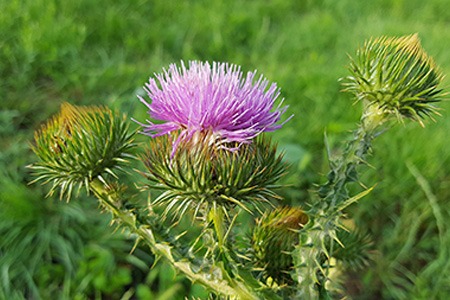
Musk thistle (Carduus nutans) is a near-alien plant that looks almost like a sideways dandelion. This plant is invasive and will grow in the most hazardous conditions. For example, musket thistle prefers to cultivate in disturbed locations like roadways and pastures, where they attach to others so the seeds can grow in new places.
Musk thistles look like purple sunflowers and grow on thick stems. However, these plants have no natural predators since animals won’t eat them, making them highly invasive. Humans are their only natural combatant, and these plants bloom every other year. Some musk thistles can grow up to seven feet tall and be anywhere from four to 18 inches wide at the head.
Purple Deadnettle
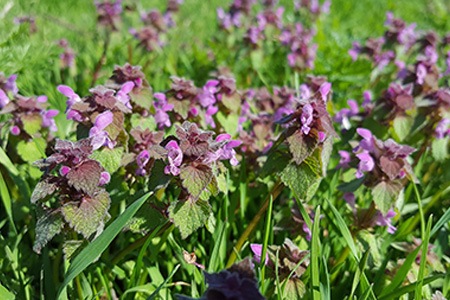
Purple deadnettle (Lamium purpureum) is a weed that comes from Europe and Asia but has since made an appearance in Noth America. These purple weeds in your grass will stick close to the ground and blooms during warm conditions. You can expect to see this flower, sometimes called Henbit deadnettle, creep along the ground most often during Spring or Summer.
Purple deadnettle enjoys growing in home lawns or gardens and can grow together with other weeds. Although this plant can survive in some shade, it will thrive most in full sun and moist soil, making summer showers the perfect time for these weeds to bloom.
Canada Thistle
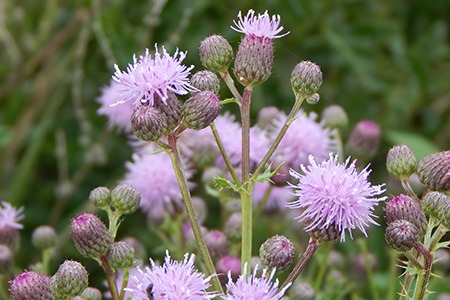
Canada thistle (Cirsium arvense) is also called creeping thistle and initially appeared in Europe. However, colonizers brought the weed to the United States in the 1600s, where it spread throughout the continent, including Canada. This perennial is invasive and grows extensive roots that will strangle other plants in the area.
Canada thistle can grow up to five feet tall and produces mostly purple flowers that top almost all of its branching stems. Sometimes, Canada thistle will grow white or pink flowers, but these are less common. This plant is most often seen in July when the weather is warmest, and the flowers produce a fluffy top full of seeds to be swept away with the wind to seed another area.
Creeping Charlie
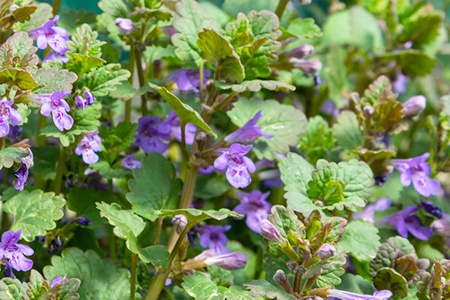
Creeping Charlie (Glechoma hederacea) is also called ground ivy and will keep low to the ground. This type of ivy will spread by planting stems against the ground and moving about the lawn and garden. As creeping Charlie grows, it will sprout purple flowers that will pop out close to the stem, making a cute, although destructive, display.
Creeping Charlie is native to Europe and got brought by colonizers to America, where it flourished. This plant can be kept in a pot, away from other plants and plots of land, where it can invade and ruin the natural lawn and garden look. Interestingly, Creeping Charlie has a mild mint aroma that appeals to many homeowners despite it being one of the lawn weeds with purple flowers to avoid.
Common Thistle
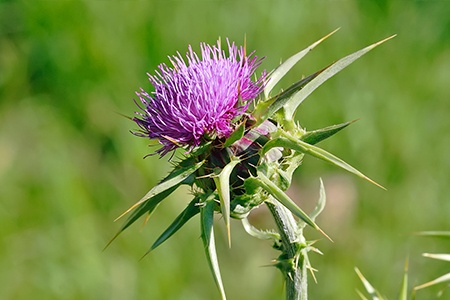
Common thistle (Cirsium vulgare) is also called spear thistle and has an aggressive look that will likely keep predators and livestock away. This plant will spout a bulbous purple flower atop its stems, sometimes in bunches. This plant will bloom once every two years and grow close together to create a dense mound of leaves and stems.
Common thistle is invasive and will suffocate other plants in the area until it’s the only one left. However, this plant will attract bees and butterflies.
Purple Flower Weed FAQ’s
These answers can help you decide which type of purple-flowered weed you have in your lawn or garden and how to handle them.
What are Those Purple Weeds Called?
There are many purple weeds, but the most common are henbit and purple deadnettle. These purple weeds can grow nearly anywhere and have purple or pinkish flowers on top of dark-colored stems.
How Do I Get Rid of Purple Deadnettle?
Purple deadnettle is invasive, but it prefers the colder seasons the most. You can use a postemergence herbicide to manage the purple weeds in your lawn before they crop up.
What are the Purple Weeds Growing in My Lawn?
The most common purple weed in lawns is the purple deadnettle, which exists in the mint family. This weed is highly invasive and will spread quickly across the whole lawn if you aren’t careful.
What are the Purple Weeds in Early Spring?
Purple deadnettle and henbit are the earliest weeds to crop in Spring since they enjoy cold weather the most. These weeds prefer locations without much disruption.
Are Purple Weeds Poisonous?
Purple weeds are safe and not poisonous flowers. However, monitor yourself and your family for any skin reactions or rashes when interacting with weeds with purple flowers.
Those Small Purple Weeds in Your Grass
Although purple flowered weeds are not poisonous, they can creep along and kill many of the flowers or plants in your garden. Removing them can be an ideal way to keep your garden fresh, healthy, and vibrant. You may want to keep a patch of weeds. However, they will need near-daily maintenance to prevent infecting the rest of your lawn and garden.
Herbicides can kill more weeds with purple flowers and make your garden look safe and healthy. First, identify what type of weed you have in your garden to devise your plan of action. Some herbicides can kill your lawn or other plants in your garden.



